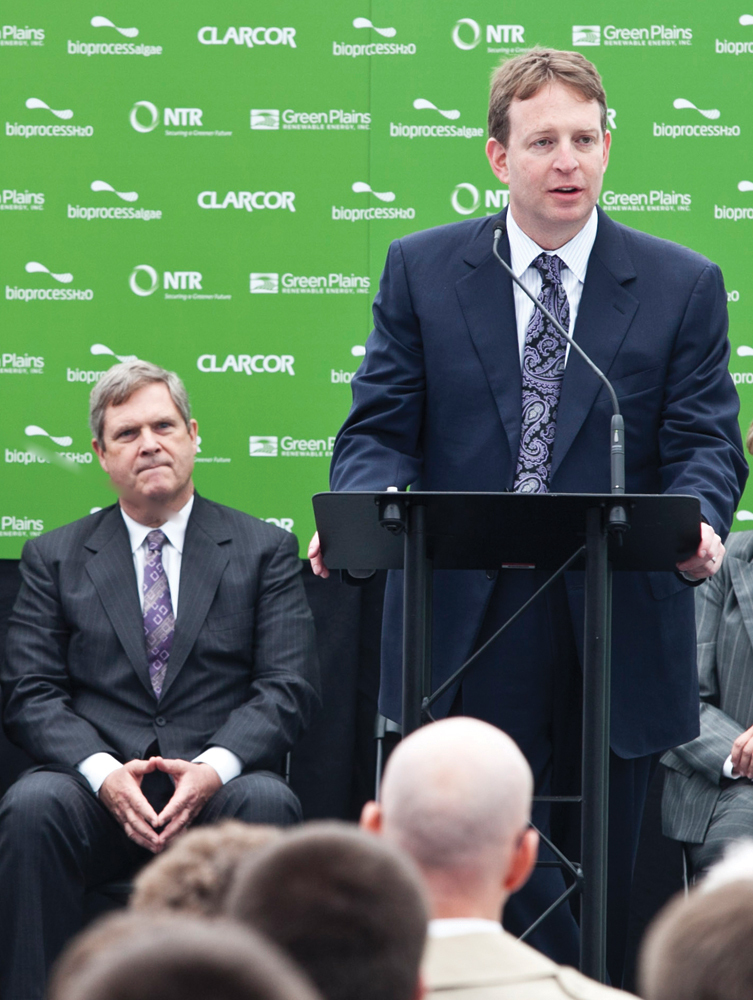Outlook 2012: Fighting Vigorously to Defend the RFS



November 15, 2011
BY Holly Jessen
For every gallon of ethanol sold, that’s one gallon of gasoline that Big Oil doesn’t sell. And that, says Todd Becker, president and CEO of Green Plains Renewable Energy Inc., doesn’t make the petroleum industry happy. As a result, the renewable fuel standard (RFS) will remain under attack. “We’re going to have to fight vigorously to defend the RFS, because they are going to come after it,” he tells EPM.
Becker considers that battle the single most important issue facing the ethanol industry today. Minus a market for U.S.-made fuel, it would mean a mandate for $3 corn and unprofitable agricultural producers. “All they want to do is move the profitability off the farm and into their hands, and I think that’s absolutely wrong,” he says.
Defending the RFS isn’t just about ensuring a market for corn-based ethanol, such as what GPRE produces at its nine ethanol plants with a total capacity of 740 MMgy. It’s also about reaching goals for the future. “If you blow up the RFS, you blow up any chance of next-generation fuels hitting the market,” he says.”I think that’s the basic issue at hand.”
Advertisement
Advertisement
GPRE regards 2012 optimistically due to five fundamental factors. First on the list is the RFS mandate for 13.2 billion gallons in 2012. Next is the E15 waiver, which was approved by the EPA but has not yet resulted in retail sales at the pump. “Hopefully we see some early implementation with early adopter states,” Becker says. Another area where ethanol has found a market is blending with 84 octane gasoline—which, without ethanol’s octane boosting power wouldn’t even be allowed to leave the terminal. This is allowing refiners to switch over refining capacity to producing more conventional blendstock for oxygenate blending, commonly known as CBOB, which creates a market for ethanol producers, Becker says.
Then there are ethanol export opportunities to consider. Export totals through August show that U.S. ethanol producers are on track to export a whopping 900 million gallons by the end of 2011—a dramatic increase from 2010, which was also a big increase from 2009. Notably, exports to Brazil have been up due to short sugar cane harvests and increased domestic demand, an issue that doesn’t appear will quickly self-correct. “We expect that ethanol will remain competitive to Brazil and the world,” Becker says.
Advertisement
Advertisement
Last but not least, GPRE believes blend economics are positive—even without the Volumetric Ethanol Excise Tax Credit, which is widely expected to sunset at the end of the year. GPRE has long lobbied for VEETC reform, even when that position wasn’t popular. As one of the few publically owned ethanol producers, GPRE often faces the misconception that ethanol producers receive the tax credit directly when in fact VEETC is a blenders credit. “We always think we have a bull’s-eye on our back when we walk into investor meetings, “he says. “They always ask us how much of the tax credit do we get. It gets a little tiring after awhile and we’re very happy to see it go away.”
Ultimately, GPRE has faith in the product. “We believe that ethanol can compete with oil on a head-to-head basis for a place in the motor fuels supply,” he said. Looking back on 2011, there’s no doubt it was a year of volatility. Still, the industry as a whole did fairly well. Becker believes that’s because of a more disciplined approach to managing the margins. “In general, we’re a lot healthier as an industry then we were in the past,” he says. “We’re finding more and better ways to more efficiently run our ethanol plants and finding new areas of growth within the kernel of corn. We’re not afraid to deploy capital to improve our operations, and I think overall, that’s all just going to be good for the industry.”
GPRE was profitable in 2011 for the third year in a row. “We expect that 2012 will be no different from that perspective,” he says. “We expect to remain profitable, driven by our low-cost platform and our risk management systems.” The company will continue to look for ethanol plants to acquire. “We think scale is meaningful and it is very cost effective,” he says, adding that with each acquired ethanol plant, GPRE has been able to drive down costs in a significant way.
And, GPRE will continue to focus on vertical integration with its other agribusiness segments. “Don’t forget, we’re not just an ethanol company, we make over $50 million dollars a year of additional operating income from other businesses,” he says. “We are going to look for opportunities to grow each and every component—not just the ethanol component. We believe that all of those are important to make any profitability through times of volatility.”
Author: Holly Jessen
Associate Editor, Ethanol Producer Magazine
(701) 738-4946
hjessen@bbiinternational.com
Upcoming Events





